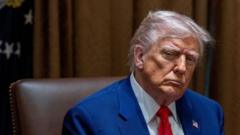Trump's recent tariff plan aimed to transform the global economic landscape, but a sudden pause on increased tariffs has left many wondering about the effectiveness of his agenda. Originally boasting bold aspirations like better trade deals and boosting American manufacturing, let's break down his five main goals and their current statuses.
1) **Better trade deals:**
Trump's aggressive tariff strategy sent shockwaves throughout the world, causing countries to scramble for concessions. As negotiations with allies like South Korea and Japan unfold, the administration claims it has garnered attention from over 75 world leaders eager to seek deals. The urgency is palpable, as the clock is ticking down on Trump's 90-day ultimatum to strike agreements.
2) **Boosting American industry:**
While Trump promises a manufacturing renaissance, the unpredictability of his tariff approach makes businesses hesitant to commit. Companies prefer stable regulations before investing in reshoring production. With constant changes, corporations might hold off on major investments, waiting for clearer guidelines.
3) **Facing off with China:**
Amidst rising tensions with China, Trump's approach has shifted. While he recognizes China's role in trade disputes, he admits the real issues lie with previous US leadership. A high-stakes showdown could risk alienating key allies, complicating America's position against the world's second-largest economy.
4) **Raising revenue:**
Trump's proposed tariffs were envisioned as a significant revenue source, with estimates predicting a $2 trillion influx over the next decade. However, as consumers adjust to potential price hikes, it's unclear how this revenue stream will ultimately be affected, especially as domestic production rises and shifts economic dynamics.
5) **Lower prices for consumers:**
Trump's stance promotes the idea of increased competition leading to lower consumer prices. Yet experts warn that tariffs often inflate costs. Projections suggest that households could see price increases averaging $1,253 in the first year alone, potentially hitting low-income families the hardest.
As Trump's second term continues to unravel, the impact of his tariff strategy remains uncertain, proving that the road to his economic plans may be bumpier than anticipated.
1) **Better trade deals:**
Trump's aggressive tariff strategy sent shockwaves throughout the world, causing countries to scramble for concessions. As negotiations with allies like South Korea and Japan unfold, the administration claims it has garnered attention from over 75 world leaders eager to seek deals. The urgency is palpable, as the clock is ticking down on Trump's 90-day ultimatum to strike agreements.
2) **Boosting American industry:**
While Trump promises a manufacturing renaissance, the unpredictability of his tariff approach makes businesses hesitant to commit. Companies prefer stable regulations before investing in reshoring production. With constant changes, corporations might hold off on major investments, waiting for clearer guidelines.
3) **Facing off with China:**
Amidst rising tensions with China, Trump's approach has shifted. While he recognizes China's role in trade disputes, he admits the real issues lie with previous US leadership. A high-stakes showdown could risk alienating key allies, complicating America's position against the world's second-largest economy.
4) **Raising revenue:**
Trump's proposed tariffs were envisioned as a significant revenue source, with estimates predicting a $2 trillion influx over the next decade. However, as consumers adjust to potential price hikes, it's unclear how this revenue stream will ultimately be affected, especially as domestic production rises and shifts economic dynamics.
5) **Lower prices for consumers:**
Trump's stance promotes the idea of increased competition leading to lower consumer prices. Yet experts warn that tariffs often inflate costs. Projections suggest that households could see price increases averaging $1,253 in the first year alone, potentially hitting low-income families the hardest.
As Trump's second term continues to unravel, the impact of his tariff strategy remains uncertain, proving that the road to his economic plans may be bumpier than anticipated.




















